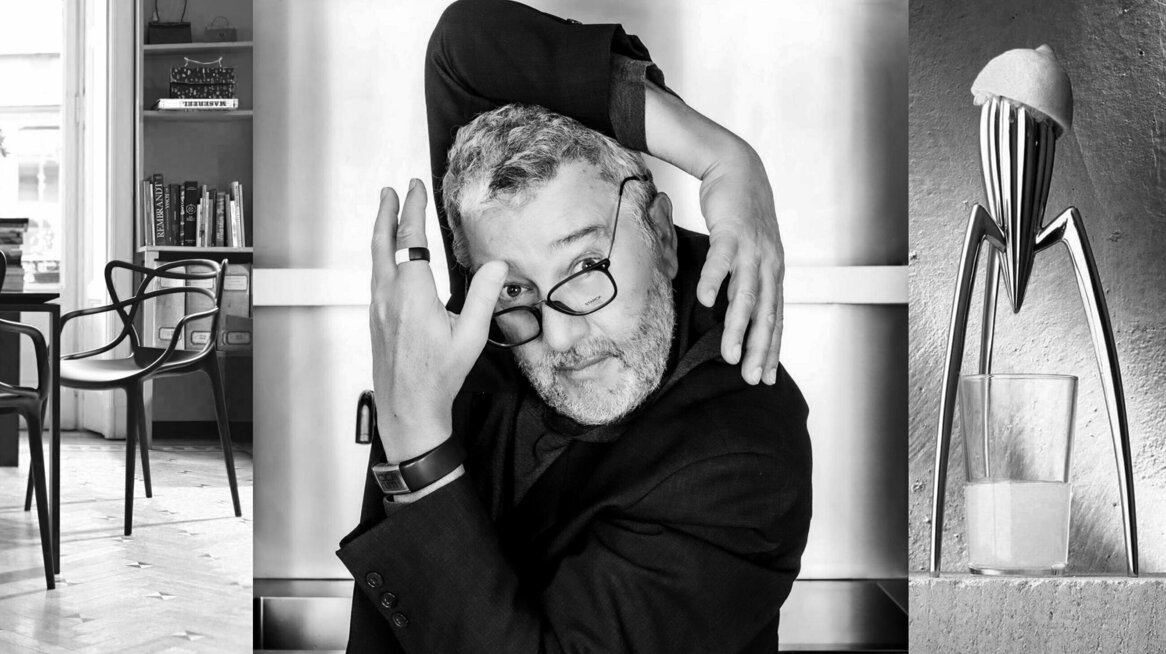Pioneer of democratic design: Who is Philippe Starck?
Described as the only designer to achieve “rock star” status, Starck is a genius who receives as much criticism as he does praise. Modern but distrustful of progress, cautiously "putting himself forward" but disdainful of the press, Starck built a hugely prolific design empire over the course of his career.

His approach to design, which ranges from stylish hotels to toothbrushes, defies any conventional classification; With his versatile creativity, he always focuses on what is essential. He believes that creation, in whatever form it takes, should improve the lives of as many people as possible. Considered one of the pioneers of the concept of "democratic design" due to this philosophy, Starck has become one of the most visionary creators of the international contemporary scene with his ideas and boundary-pushing designs developed in all fields from daily products to architecture, maritime, and space engineering.
Who is Philippe Starck?
"Disruptive, ethical, ecological, political, humorous... This is how I see my duty as a designer," said Starck, who created many iconic creations with his prophetic awareness of ecological consequences, enthusiasm for imagining new lifestyles, and determination to change the world. Born in 1949, Starck, thanks to his father, an aeronautical engineer, from his childhood spent under the drafting tables of aircraft building, has been involved in everything from everyday products such as furniture and lemon squeezers to revolutionary mega yachts, extremely vibrant, inspiring and fantastical hotels and the miraculous creations of individual wind turbines and electric motors. It never ceases to push the boundaries and criteria of contemporary design, including technologies.
Philippe Starck (born 18 January 1949) is a French industrial architect and designer known for his wide range of designs, including interior design, architecture, household objects, furniture, boats and other vehicles.
In 1976, after the creation of many iconic objects such as a floating lamp and a portable neon sign, this bold dreamer designed a daring decor for the La Main Bleue nightclub in Montreuil. He completed the legendary nightclub Les Bains Douches in Paris and the Starck Club in Dallas. He also founded the first industrial design company, Starck Product, which he later renamed Ubik, inspired by the famous Philip K Dick novel. Here he started his collaborations with Italy's largest design manufacturers, Driade, Alessi, Kartell and the world's largest design manufacturers.
He became known to the public in 1983, when, upon the recommendation of Minister of Culture Jack Lang, he chose the project to decorate President François Mitterrand's private residence in the Elysée Palace. The following year, his international reputation was cemented thanks to the success of Café Costes, a new venue both functional and elegant, incorporating the full essence of Starck architecture, combined with the birth and development of a community.
Philippe Starck refuses to impose his own solutions and says, “My job is like directing a movie. I tell stories and offer the public the most complete spiritual concept possible of the places they visit. “Public spaces are, above all, about emotions and experiences.” Because the basis of all Starck's projects lies in commitment to humanity and the desire to create strong emotions through the creation of spaces; This allows everyone to discover what they are looking for and more when entering these buildings.
Although he considered himself more of an architect than a designer, in the early 1980s Philippe Starck designed many buildings with forms never before seen in Japan. The first was in Tokyo, completed in 1989, and was remarkable for its originality. Nani Nani was an impressive, anthropomorphic structure covered in living materials that evolved over time.
A year later, he confirmed his position as a leader of avant-gardist architecture with the Asahi Beer Hall in Tokyo, followed by a series of offices known as Baron Vert in Osaka in 1992. In France, he was commissioned to design the control tower at Bordeaux airport (1997) and the extension of the Ecole Nationale Supérieure des Arts Décoratifs in Paris (1998). Jean Paul Gaultier also entrusted his imagination with the transformation of his boutiques in Paris, London, and New York.
Philippe Starck also shows a real commitment to public spaces, where he hopes to establish a humane community committed to striving for change. "It is time to remember that living together also means living in harmony," said the designer, and he turned this idea into reality with Alhondiga, a cultural center spread over approximately 30,000 m2 in Bilbao in 2012.
Starck, which has never stopped revolutionizing the rules of the hotel world since its first creation, has left its mark on the hotel industry since the 1980s. Under his influence, hotels are no longer temporary and impersonal transitional spaces; They turn into friendly, fun living spaces. In 2005, Faena Hotel, which opened in Buenos Aires the previous year, was chosen as the best hotel of the year by Wallpaper magazine.
